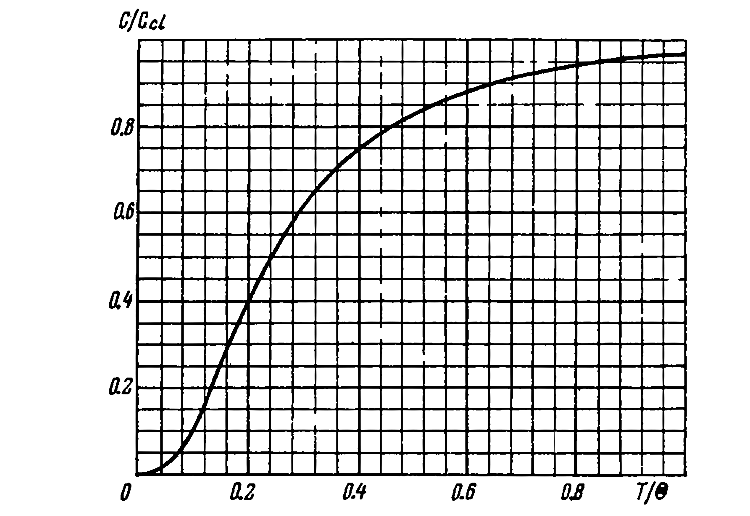Can one consider the temperature 20and30K as low for to 0.226 and 0.760J/(mol.K)?
At low temperature C∝T3. This is also a test of the "lowness" of the temperature We see that
(C1C2)1/3=1.4982≈1.5=T1T2=3020
Thus T3 law is obeyed and T1,T2 can we regarded low.
Topper's Solved these Questions
- ATOMIC AND NUCLEAR PHYSICSBOOK - IE IRODOV, LA SENA & SS KROTOVCHAPTER - ATOMIC AND NUCLEAR PHYSICSEXERCISE - Radioactivity
35 Videos
- ATOMIC AND NUCLEAR PHYSICSBOOK - IE IRODOV, LA SENA & SS KROTOVCHAPTER - ATOMIC AND NUCLEAR PHYSICSEXERCISE - Nuclear Reaction
42 Videos
- ATOMIC AND NUCLEAR PHYSICSBOOK - IE IRODOV, LA SENA & SS KROTOVCHAPTER - ATOMIC AND NUCLEAR PHYSICSEXERCISE - Properties Of Atom
69 Videos
- DIRECT CURRENTBOOK - IE IRODOV, LA SENA & SS KROTOVCHAPTER - DIRECT CURRENTEXERCISE - All Questions
15 Videos
Similar Questions
Two moles of ideal helium gas are in a rubber balloon at 30∘C. The balloon is fully expandable and can be assumed to require no energy in its expansion. The temperature of the gas in the balloon is slowly changed to 35∘C. The amount of heat required in raising the temperature is nearly (take R
=8.31J/mol.K)
View SolutionFigure. 6.10 shows heat capacity of a crystal vs temperatue in terms of the Debye theory. Here Ccl is classical heat capacity Θ is the Debye temperature. Using this plot, find:
(a0 The Debye temperature for silver if at a temperature T=65K its molar heat capacity is equal to 15J(mol.K),
(b) the molar heat capacity of aluminum at T=80K if at T=250K it is equal to 22.4J(mol.K)
(c )the maximum vibration frequency for copper whose heat capacity at T=125K differs form the classical value by 25%.

View Solution
Knowledge Check
The rate of a reaction doubles when its temperature changes form 300K to 310K. Activation energy of such a reaction will be:
(R=8.314JK−1mol−1andlog2=0.301)A53.6 kJ mol−1B48.6 kJ mol−1C58.5 kJ mol−1D60.5 kJ mol−1One mole of an ideal gas is allowed to expand reversible and adiabatically from a temperatureof27∘C)if the work done during the process is3kJ,the final temperature will be equal to(Cv=20JK−1)
A100kB450kC150kD400kThe ratio of translational and rotational kinetic energies at 100K temperature is 3:2. Then the internal energy of one mole gas at that temperature is (R=8.3j/mol−K]
A1175JB1037.5JC2075JD4150J
The kinetic energy of one gram molecule of a gas at normal temperature and pressure is (R=8.31J/mol−K)
View SolutionThe ratio of translational and rotational kinetic energies at 100K temperature is 3:2. Then the internal energy of one mole gas at that temperature is (R=8.3j/mol−K]
View SolutionA sample of 3.0 mole of perfect gas at 200K and 2.0atm is compressed reversibly and adiabatically until the temperature reaches 250K. Given that molar heat capacity at 27.5JK−1mol−1 at constant volume calculate q,W,ΔU,ΔH and the final pressure and volume.
View SolutionA sample of 3.0 mole of perfect gas at 200K and 2.0atm is compressed reversibly and adiabatically until the temperature reaches 250K. Given that molar heat capacity at 27.5JK−1mol−1 at constant volume calculate q,W,ΔU,ΔH and the final pressure and volume.
View SolutionThe temperature in K at which ΔG=0 for a given reaction with ΔH=−20.5kJmol−1 and ΔS=−50.0JK−1mol−1 is
View Solution
